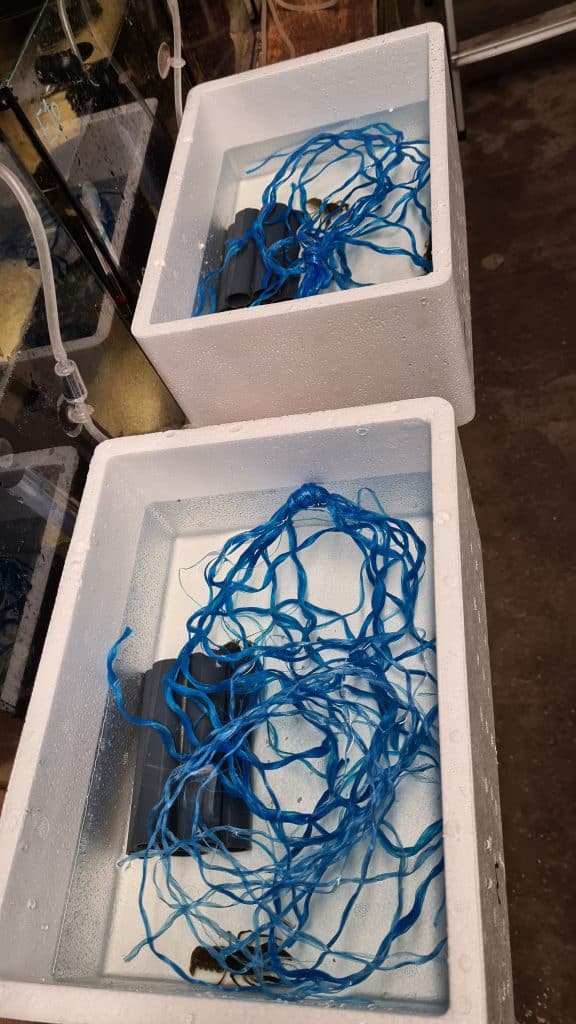If you have been in our bug house, you may have noticed recently that we have some new much smaller white clawed crayfish. The originals that we held onsite from the 30th of June last year until a few weeks ago, have now gone back to their native home of Bristol. This has allowed us to take on another 74 young crayfish. They hatched back at the end of May last year, again from Bristol.

This move marks our continued conservation efforts with this endangered English species.
“There are an estimated 650 freshwater crayfish species globally and approximately a third of all crayfish species are threatened with extinction, including all five species native to Europe.” (Marshall I. & Nightingale J. 2021, Crayfish Conservation Manual, Bristol, Rostra Publications, 2021).
We will now be housing these new animals until around the same time next year. Then we are hoping that they will be able to be released back into the rivers that their mothers were collected from.
The Hows and Whys
This type of conservation happens where pregnant females are collected from the wild and housed whilst they give birth. The young are then collected to be temporarily cared for in captivity. After this, females are safely released back into their native habitats. The young are cared for in a captive setting, protected from disease and predation. Threats to crayfish are highest during their first year after hatching. Therefore, this type of conservation hopes to eliminate some of this risk to the young.

Care In Captivity
Keeping crayfish in captivity is no easy task. Water quality playing a large part in housing them. The invertebrate keepers must spend a lot of time collecting rainwater from our water collection points. They are situated in our off-show areas and then transferred to large storage tanks in the crayfish hatchery. This water is then aerated continuously before it is used to top up our tanks. The crayfish tanks each have a 20-25% water change each week to ensure that the water quality is maintained. White clawed crayfish are very susceptible to ammonia and nitrite which if not controlled are lethal to livestock.
Nitrite is produced from oxygen and ammonia mixing, when Nitrosomonas bacteria breaks down ammonia into nitrite. Ammonia is produced from uneaten food and from the crayfish’s poo. Therefore, each tank is syphoned daily to remove as much waste as possible.
The water is tested on a weekly basis for each tank and each water system used to ensure that levels are what they should be. If we need to make slight adjustments to correct levels, then this can be done using various methods such as the water changes.
The temperatures for each tank are also recorded twice daily. Again, this ensures that the environment for this sensitive species is appropriate. The temperature for the entire crayfish hatchery can be changed via water cooling systems and two air conditioning units. For staff this is a very cold room to work in. Particularly since our invertebrate keepers go from working in the bug section at temperatures of 30 degrees down to 5 degrees in the crayfish room.

Crayfish Diet
White clawed crayfish are omnivores and are therefore fed a diet based on both plant and animal material. We make up large quantities of this diet and then freeze it down into small cubes. This allows for easier feeding.
Future Hopes for Crayfish Conservation
We hope in the future that we will be able to collect our own White Clawed Crayfish from local river systems in Kent. This would be for the same types of projects and to potentially have our own captive breeding stock to help boost local numbers even further.
There is still a lot more work to do locally, with surveys of our waterways to find wild populations and what numbers are present. Water quality testing for these potential ark sites is necessary. Plus, improvements will need to be made to ensure any animals (remaining stock or captive animals released back into the wild) have the best chances at survival.
To find out more about this project check out my previous blog here. We are also on the look out for engineering bricks which these youngsters will love crawling into the holes of as they grow. If you have any you can donate to the park we would be very grateful. Thank you!


